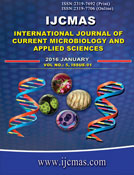


 National Academy of Agricultural Sciences (NAAS)
National Academy of Agricultural Sciences (NAAS)

|
PRINT ISSN : 2319-7692
Online ISSN : 2319-7706 Issues : 12 per year Publisher : Excellent Publishers Email : editorijcmas@gmail.com / submit@ijcmas.com Editor-in-chief: Dr.M.Prakash Index Copernicus ICV 2018: 95.39 NAAS RATING 2020: 5.38 |
To Study the maternal mortality ratio in Thi-Qar, describe clinical characteristics and circumstances associated with maternal deaths, identification of the main cause of maternal death, study the risk factors leading to maternal death in Thi-Qar, & to assess the burden of complications related to pregnancy the coverage of key maternal health interventions. This was a cross sectional analytical study of the maternal death in Thi-Qar city, extended from 1 st January 2010 to the 31 th of December 2012. The sample included the 59 women, aged 15 49 years, who were classified as maternal deaths. Standard definitions of maternal mortality and direct cause of death and indirect causes were used. Non pregnancy related deaths were not included. The study was carried out in 2 central hospitals and 4 peripheral health centers. certain risk factors were studied by comparing maternal death among different categories (age, parity, place of delivery, type of delivery and residency, gestational age, maternal complications on admission, pregnancy stage, stage of labour, birth attendant at delivery, patient who referred from lower level clinical facilities or self referred from home or by a traditional birth attendant). The intention was to examine the certificates and compile two sets of data one for direct causes of death (e.g., infection, eclampsia, ruptured uterus) and another for indirect causes (e.g., Medical disorders). Where multiple causes of death were recorded, the primary cause was identified using available documentation and postmortem reports. For 2010, 2011, 2012 the maternal mortality ratios were 29, 36, 25per 100 000 live births respectively. The present study showed that the majority of the deaths were among women of the age group between 30 34 years in 2010, 2011 (31.6%, 37.5%) respectively and in 2012, the majority of deaths were among women of the age group between 35 39 years (31.3 %), the majority of the deaths were among multigravida 42.1%, 54.8%, 43.8% respectively, the majority of maternal deaths were in rural area 38 (46.4%), the majority of the deaths were at postpartum stage 54.2%, direct deaths accounted for the majority of deaths& the leading cause of direct death was postpartum haemorrahge, which account about 40.54% from the total % of direct death followed by antepartum haemorrahge and eclampsia 21.63, 21.63 respectively & showed the cardiac cause is the leading cause of indirect deaths was account 68.17% of the total indirect deaths. This study provides important information about a range of socio- demographic, clinical &health system factors,which are identified as possible contributors to Thi- Qar,poor progress towards reducing maternal mortality. We conclude that vital managerial change is required; including formulation of therapeutic protocols for primary obstetric health care services. Without these, our efforts will be useless, with little impact on saving women s live.
 |
 |
 |
 |
 |